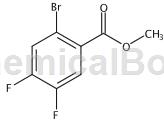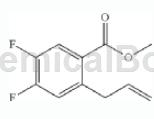background and overview[1]
methyl 2-bromo-4,5-difluorobenzoate can be used as a pharmaceutical synthesis intermediate. if 2-bromo-4,5-difluorobenzoic acid methyl ester is inhaled, move the patient to fresh air; if skin contact occurs, remove contaminated clothing and rinse the skin thoroughly with soap and water. if discomfort occurs , seek medical attention; if eye contact occurs, separate eyelids, rinse with running water or saline, and seek medical attention immediately; if ingested, rinse mouth immediately, do not induce vomiting, and seek medical attention immediately.
structure

preparation[1]
methyl 2-bromo-4,5-difluorobenzoate was prepared as follows: 2-bromo-4,5-difluorobenzoic acid (1 g, 4.22 mmol) was dissolved in dichloromethane (10 ml) and meoh ( add trimethylsilyl)diazomethane (2.110 ml, 4.22 mmol) to the mixture in 1 ml) and stir the reaction. 1 hour at room temperature. it was then concentrated to obtain methyl 2-bromo-4,5-difluorobenzoate (1 g, 3.98 mmol, 94% yield) as an oil.
apply[2]
methyl 2-bromo-4,5-difluorobenzoate can be used as a pharmaceutical synthesis intermediate. for example, prepare the following compounds:

the specific steps are: 2-bromo-4,5-difluorobenzoic acid methyl ester (0.5g, 1.992mmol), allyltributylstannane (0.679ml, 2.191mmol), lithium chloride (0.169g, to a mixture of 3.98 mmol) in dmf (1 ml), acetonitrile (10 ml) was added bis(triphenylphosphine)palladium(ii) dichloride (0.070 g, 0.100 mmol). it was then degassed for 2 minutes and then filled with n2. after heating at 90°c for 16 hours, it was quenched with nh4cl and extracted with etoac. the organic layer was washed 5 times with kf solution, then dried over mgso4, filtered and concentrated to give an oil, which was then purified by biotage, eluting with 10% etoac/hexanes to isolate methyl 2-allyl-4,5 -difluorobenzoate (330 mg, 1.555 mmol, 78% yield) as oil.
main reference materials
[1] wo2015126737 pyrazolopyrimidinemacrocyclesasinhibitorsofhumanimmunodeficiencyvirusreplication
[2] us20150232481 pyrazolopyrimidine macrocycles as inhibitors of human immunodeficiency virus replication

 微信扫一扫打赏
微信扫一扫打赏

